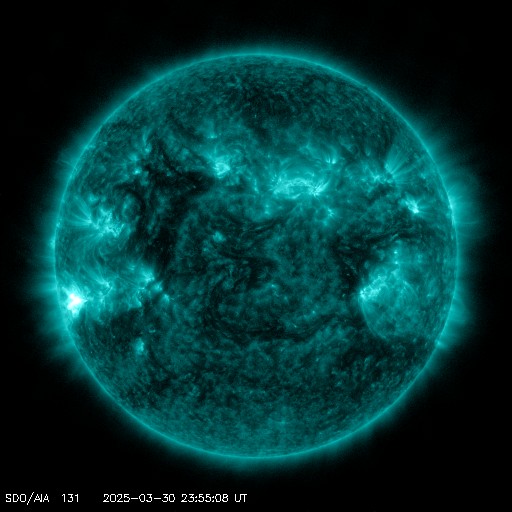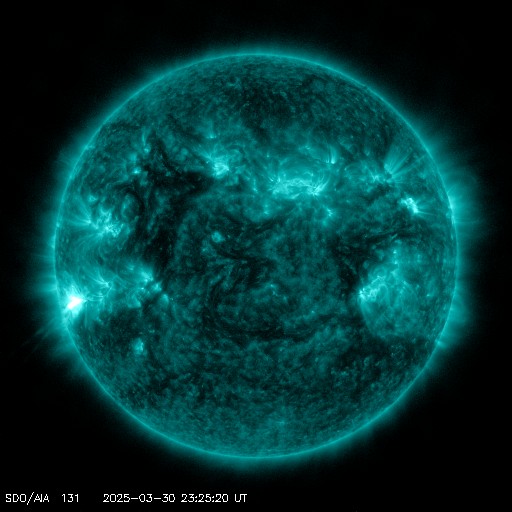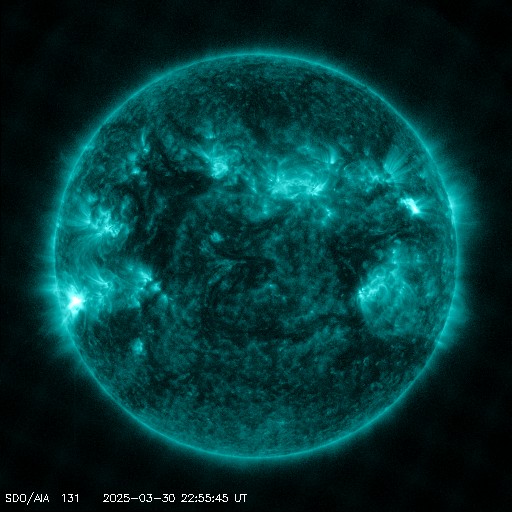Viewing archive of Friday, 25 March 2011
Solar activity report
Any mentioned solar flare in this report has a scaling factor applied by the Space Weather Prediction Center (SWPC). Because of the SWPC scaling factor, solar flares are reported as 42% smaller than for the science quality data. The scaling factor has been removed from our archived solar flare data to reflect the true physical units.
Report of Solar-Geophysical Activity 2011 Mar 25 2200 UTCPrepared by the NOAA © SWPC and processed by SpaceWeatherLive.com
Joint USAF/NOAA Report of Solar and Geophysical Activity
SDF Number 084 Issued at 2200Z on 25 Mar 2011IA. Analysis of Solar Active Regions and Activity from 24-2100Z to 25-2100Z
Solar activity was at low levels. Only isolated B-class
and low-level C-class events were observed during the period, all
from Region 1176 (S16E30). The region grew in area and spot count,
mostly from new development just to the NNE of the large leader
spot. Both Regions 1177 (N21E24) and 1178 (S15E55) developed
penumbra in their leader spots and were classified as bi-polar
C-type groups. Two new regions rotated on the disk during the
period; Region 1180 (N26E66) and Region 1181 (S23E69), both H-type
groups. A partial Halo CME was first observed at 24/1203Z in LASCO
C3 imagery extending through the northern hemisphere of the solar
disk. The likely source was from the M1/1f flare from Region 1176 at
24/1207Z.
IB. Solar Activity Forecast
Solar activity is expected to be low
for the next three days (26 - 28 March) with a chance for M-class
activity, primarily from Region 1176.
IIA. Geophysical Activity Summary 24-2100Z to 25-2100Z
The geomagnetic field was quiet. ACE solar wind data indicated a
gradual decrease in velocities from a high of near 500 km/s at
24/2304Z to a low of about 400 km/s at 25/1438Z. During the period,
IMF Bz was variable between +5 nT and -4 nT.
IIB. Geophysical Activity Forecast
The geomagnetic field is
expected to be at predominately quiet levels for the days one and
two (26 - 27 March). By day three (28 March), quiet to unsettled
conditions, with isolated active periods, are possible due to
effects from the 24 March CME.
III. Event Probabilities 26 Mar to 28 Mar
| Class M | 40% | 40% | 40% |
| Class X | 05% | 05% | 05% |
| Proton | 01% | 01% | 01% |
| PCAF | green | ||
IV. Penticton 10.7 cm Flux
Observed 25 Mar 113 Predicted 26 Mar-28 Mar 120/125/130 90 Day Mean 25 Mar 096
V. Geomagnetic A Indices
Observed Afr/Ap 24 Mar 003/004 Estimated Afr/Ap 25 Mar 003/004 Predicted Afr/Ap 26 Mar-28 Mar 005/005-005/005-010/005
VI. Geomagnetic Activity Probabilities 26 Mar to 28 Mar
| A. Middle Latitudes | |||
|---|---|---|---|
| Active | 10% | 10% | 20% |
| Minor storm | 01% | 01% | 05% |
| Major-severe storm | 01% | 01% | 01% |
| B. High Latitudes | |||
|---|---|---|---|
| Active | 15% | 15% | 25% |
| Minor storm | 01% | 01% | 10% |
| Major-severe storm | 01% | 01% | 01% |
All times in UTC
Current data suggests there is a slight possibility for aurora to appear at the following high latitude regions in the near future
Gillam, MB, Whitehorse, YT, Yellowknife, NTAnchorage, AK, Fairbanks, AK, Juneau, AK, Utqiagvik, AK
Latest news
Latest forum messages
Solar Demon 3Unspecified geomagnetic activity 2146AR4046 134Aurora photography hints for those of us with smartphones 54AR4048 34
More topicsSupport SpaceWeatherLive.com!
A lot of people come to SpaceWeatherLive to follow the Sun's activity or if there is aurora to be seen, but with more traffic comes higher server costs. Consider a donation if you enjoy SpaceWeatherLive so we can keep the website online!

Latest alerts
00:09 UTC - Solar flare
Moderate M1.03 flare
Sunday, 30 March 2025
23:51 UTC - Radio Blackout
Minor R1 radio blackout in progress (≥M1 - current: M1.03)
23:39 UTC - Solar flare
Moderate M1.52 flare
23:21 UTC - Radio Blackout
Minor R1 radio blackout in progress (≥M1 - current: M1.49)
23:09 UTC - Solar flare
Moderate M1.48 flare
Space weather facts
| Last X-flare | 2025/03/28 | X1.1 |
| Last M-flare | 2025/03/30 | M1.0 |
| Last geomagnetic storm | 2025/03/27 | Kp5 (G1) |
| Spotless days | |
|---|---|
| Last spotless day | 2022/06/08 |
| Monthly mean Sunspot Number | |
|---|---|
| February 2025 | 154.6 +17.6 |
| March 2025 | 127 -27.6 |
| Last 30 days | 127 -25.7 |





